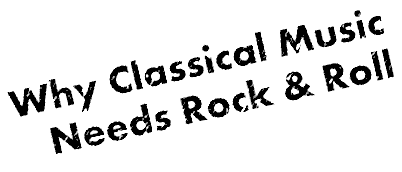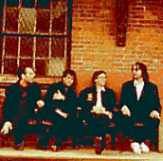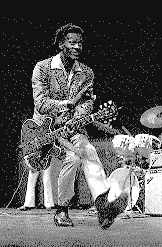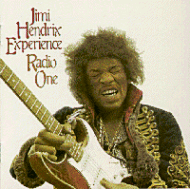

![]()
 |
There's a lot of talk
these days about reinventing classical music. Or maybe
just reinventing its marketing, but in any case doing
something to make it come alive -- and assure its
survival -- in an age of O.J. Simpson and Madonna. |
 |
Picture the scene: It's the ninth inning,
and Franco swaggers in from the bullpen to finish a game.
The sound system blares what's virtually his theme song,
Chuck Berry's "Johnny B. Goode." The crowd
sings along with the famous refrain "go, Johnny,
go"…and what's remarkable about all this, from
a classical music point of view, is that there's nothing
remarkable about it at all. We all know the song, and why
wouldn't we? It's nearly 40 years old, a beloved rock
& roll classic. This is the world classical music now
lives in -- a world in which rock (or, more accurately,
the whole range of modern rock-influenced pop, which
ranges all the way from country music to hiphop) is part
of the air we all breathe. How can classical music ever
reach new people, if it doesn't understand the music
those people already love? |
 |
To people who never leave the classical
music ghetto, that may come as a shock, but it's
absolutely true. Pop music generates commercial acts,
like the intensely sleek R&B balladeer Whitney
Houston. But it also produces artistic acts, like the
wry, compassionate rock band R.E.M. R.E.M. qualifies as
artistic because it started its career with no thought of
commercial success, because its music jumps with
unexpected shocks, and because its lyrics (shades of 20th
century high art!) are often difficult and indirect.
Against this background, how does classical music look?
How would brainy pop music fans rate the three tenors?
Against a pop music background, Carerras, Domingo, and
Pavarotti (especially Pavarotti) look just like Whitney
Houston -- safe, predictable, and bland. |
 |
And now for the third lesson.
Pop marketing isn't infallible. Some people in classical
music seem to think it is, as if pop marketers were
sinister puppeteers, and as a result can sell anything to
anybody. But that's not even remotely so. Look at Michael
Jackson, look at Prince, look at Bruce Springsteen, all
superstars who don't sell nearly as many albums as they
used to. All the marketing in the world can't bring their
careers back. |
 |
How can we fix this? In the short run,
it's more or less easy (in principle, at least).
Classical music has to be marketed like pop, which
paradoxically means presenting it more artistically. (It
could even mimic pop's implicit two-tier system, by
selling Pavarotti as a pop-music bimbo, and a refined
cellist like Yo Yo Ma as an artist.) |
 |
And from here on out, things get
adventurous. Everyone in the classical music world knows
that classical masterpieces grew -- distantly, but distinctly -- from folk-music roots. Or at least they'd
agree that the great classical composers could
incorporate folk songs in their works, with results that
sounded completely natural and didn't make anyone think
they'd betrayed their art. |
 |
But most of the classical repertoire is
hard to connect to current pop. Would we add a drum track
to Beethoven's Pastoral Symphony? But the spirit of rock,
at least, can suggest an idea or two. Beethoven's music
once was contemporary. How can we understand what that
felt like, unless we know the contemporary music of our
own time, which -- if we're talking about music that
connects to the spirit of its age the way Beethoven's did
-- would have to be rock? |
 |
copyright © 1996 by Greg Sandow |